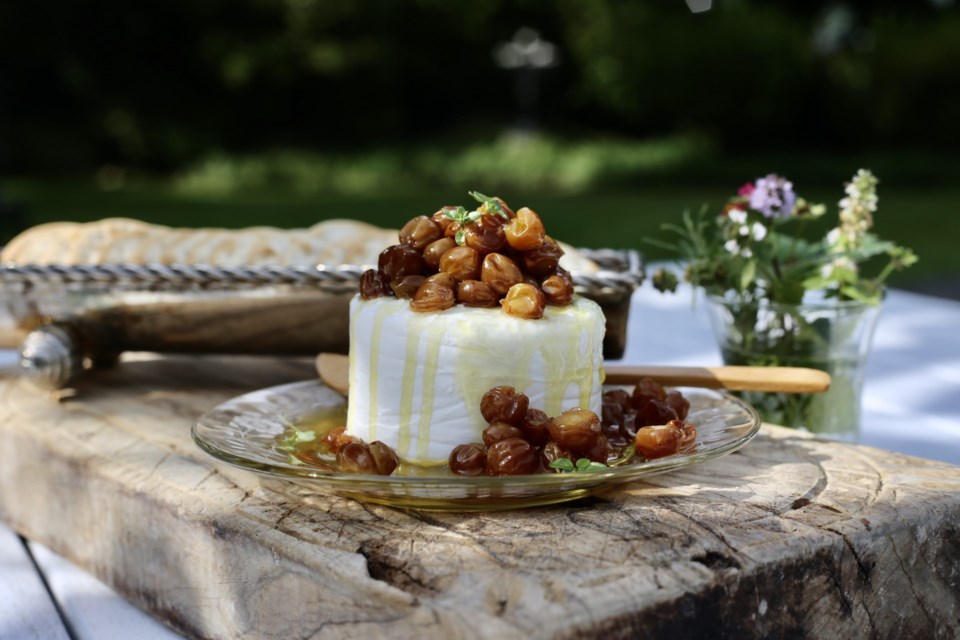Most certainly, grapes are garden pantry staples, ranking high alongside herbs, tomatoes, storage vegetables and fruit, and winter greens.
Grape plants can be used in their entirety — vines for shade, structure and decor; leaves for tannin (keeps pickles crunchy), salad greens, and for wrapping meat, cheese, rice and grain bundles; and grapes for eating, preserving, pressing, providing us with resveratrol and many other health and wellness preserving phytonutrients and natural medicines, and of course for making wine.
Bacchus, the celebrated mythical Greek god of wine (grapes), music, and ecstasy certainly had it going on — wandering about as he apparently did (naked perhaps), waving his fennel stalk-shaped, honey-soaked sceptre, anointing followers with happiness and abandon. I can think of worse fates.
It is not too late to plant wine or food grapes, and local garden centres offer a good variety.
Our grape vines love sun, circulating air, and hot feet, ie gravely, stony, rocky soil in which they can struggle somewhat.
Grapes also love to climb — walls, pergolas, fences, trellises and trees. Grape vines (plants) can be trained to grow espalier style against a sunny wall — taking advantage, long into the night, of stored energy captured by the wall’s thermal mass during the day.
Grape vines are, in my books, one of nature’s perfect food plants. Birds nest in grape vines and in tandem they fertilize and cool soil, shelter underplantings like native berries, wild greens, and tender herbs, and ultimately send nutrients back into the soil food web through decomposing leaves.
Grape vines grown along eaves cool homes naturally and energy-efficiently through dappled shades of green, white and purple all summer, and when the weather turns in the fall, shed their leaves to welcome the low-lying and warming winter sun. We accomplish a similar end with native honeysuckle.
Living on the edge of the forest as we do, we harvest grapes a few days before they are ripe. Of course we are tempted to leave them to perfect sweetness, but we know better.Racoons, bears and other wild creatures will come calling if we let any fruit ripen fully, so we don’t, not ever.
A small price to pay for the privilege and responsibility of living on the north shore among the wild things.
Some years ago, our friend Chef Robert Bartley gifted us some spectacular Interlaken grapes that he had preserved simply, in Muscat wine and dark maple syrup. They inspired me.
Today, after much experimentation, I have landed upon a new family favourite pantry staple – oven-dried interlaken raisins preserved in a simple syrup of filtered water, British Columbia ice-wine, dark maple syrup from Quebec and whole split vanilla bean (or extract).
The secret is in slow-roasting ( 110°C) the grapes (Interlaken, Coronation, or other smallish variety) on a sheet pan lightly oiled with extra virgin olive oil and then dusted with sea salt. Prop the door open a bit to allow moisture to escape, and toss the mixture now and then over the course of three hours or four hours.
Dilute ice-wine 50/50 with filtered water, add maple syrup to taste plus a split, scraped and chopped vanilla bean. Simmer the syrup to marry flavours, reduce slightly, and burn off the alcohol. Rehydrate the roasted raisins momentarily in the hot syrup and then store the cooled mixture in the fridge, or freeze for later use.
Bring the roasted grapes to room temperature before serving on a small plumpy cake of beautiful goat cheese, atop a savoury meat or vegetable tourtière, with sour cream ice cream, or on a charcuterie board. Sweet, salty, and unctuous.
Bacchus would have approved.
Laura Marie Neubert is a West Vancouver-based urban permaculture designer. Follow her on Instagram @upfrontandbeautiful, learn more about permaculture by visiting her Upfront & Beautiful website or email your questions to her here.
For a taste of permaculture, click on the YouTube link below:



